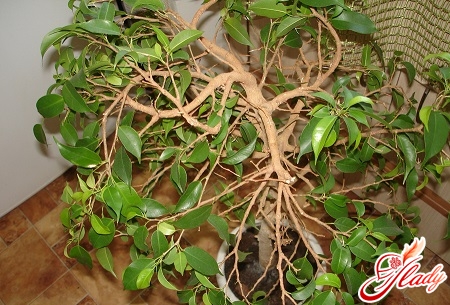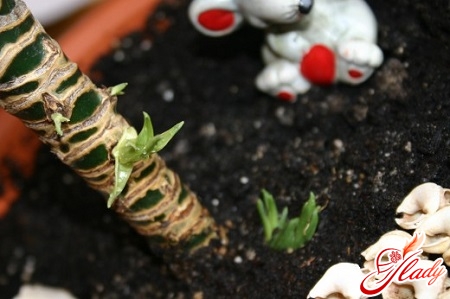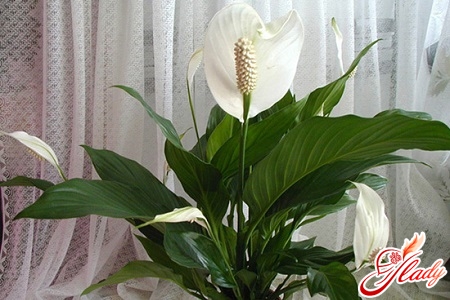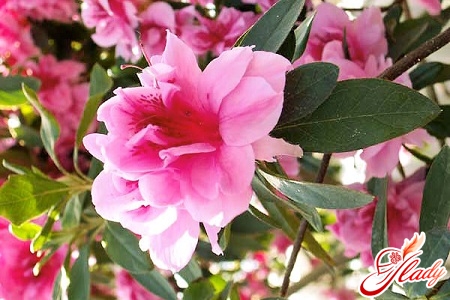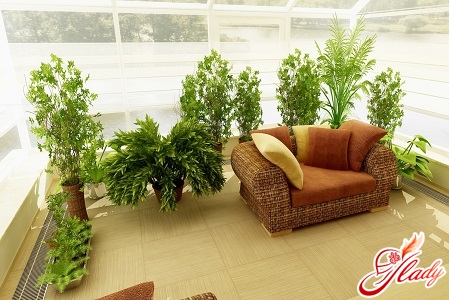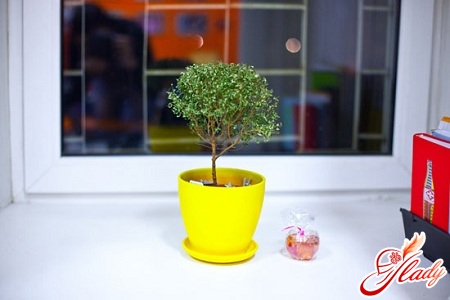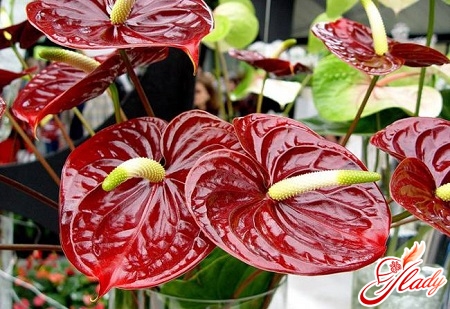 Anthurium is popularly known as "flower"flamingo" and "fiery tongue". The dense leaves of the plant, growing on thick strong petioles, can reach forty centimeters in length. This plant blooms all year round, almost without interruption. It impresses with its beauty - the flower is truly amazing. The plant is whimsical, demanding, and in order to grow a real masterpiece, you will need both time and patience. Anthurium, cared for at home properly, will delight you and your guests with bright beautiful flowers and original coloring, and will also become a worthy decoration of the home flower garden.
Anthurium is popularly known as "flower"flamingo" and "fiery tongue". The dense leaves of the plant, growing on thick strong petioles, can reach forty centimeters in length. This plant blooms all year round, almost without interruption. It impresses with its beauty - the flower is truly amazing. The plant is whimsical, demanding, and in order to grow a real masterpiece, you will need both time and patience. Anthurium, cared for at home properly, will delight you and your guests with bright beautiful flowers and original coloring, and will also become a worthy decoration of the home flower garden.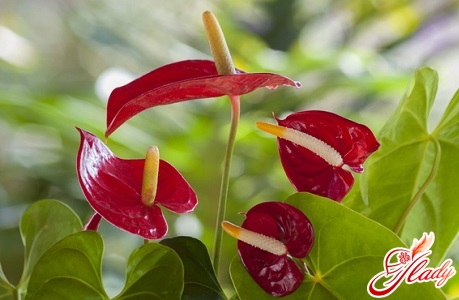
A bit about anthurium
Anthurium is a flower of the Araceae class, with manysubspecies, the most common of which is Anthurium andre. This species is native to southwestern Colombia. It also grows in northwestern Ecuador. It has a shortened stem and special aerial roots. The leaves on long petioles look like oblong hearts of a rich green color. Andre flowers have cylindrical cobs, usually white or yellow. The cover is quite dense, leathery, bright and glossy. The shape of the flowers is heart-shaped. Their color can be either delicate, light pink, or bright red. Looking at the flowers of this type of anthurium, it may seem that they are plastic - this peculiar difference distinguishes the plant from others. If you want to add a touch of exoticism to your room, then Anthurium andre is ideal for this. But be careful. All aroids, be it dieffenbachia or anthurium, are poisonous. Therefore, if you have small children or pets, try to place the flower as high as possible so that it is out of their reach. Another type of popular anthurium in home conditions is Scherzer's anthurium. It is an epiphyte, that is, a plant that has extremely short, often completely underground stems. Older Scherzer's species can grow up to forty centimeters in height. The leaves of the plant are dark green and leathery, as in the first case. However, they are more matte and have an elliptical shape. Covered with barely noticeable black dots on both sides. Scherzer's inflorescences, as a rule, rise above the plant itself. Strong specimens can have up to five inflorescences. The cover of Scherzer's anthurium is bright red, but you can find white, pink and even speckled varieties. Another type that is worth emphasizing is the crystal anthurium, which is grown rather as an ornamental foliage plant. The foliage can change color from bronze and purple to rich green. The flower has leaves up to twenty centimeters long. Their shape is heart-shaped, with a pleasant velvety surface. The leaves hang down in such a way that you can clearly see the silver veins protruding on the surface. The petioles of the plant are smooth and rounded. Peduncles reach forty centimeters, the cover up to ten centimeters long has a green and sometimes purple color.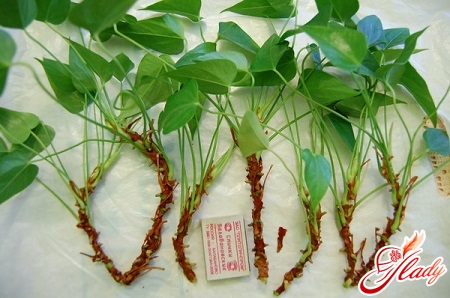
We care for an anturium
Anthurium is a flower that does not acceptяркое дневное освещение, ведь оно может губительно сказаться на росте и цветении растения. Для антуриума наиболее оптимальным является рассеянный свет и полутень. Разместить горшок с цветком лучше около северо-западного окна, однако помните, что здесь не должно быть сквозняков и температурных перепадов. Антуриум – растение, которое любит тепло. Даже в зимний период оно нуждается в температуре как минимум шестнадцать градусов. А его цветение возможно и вовсе лишь тогда, когда показатель температуры достигает 22-23 градусов. В случае охлаждения корневой системы антуриум может заболеть. По этой причине зимой убирайте горшки с растением с холодных подоконников, иначе может охладиться земляной ком, что недопустимо. Как добиться сохранения земляного тепла? Пересадите цветок в горшок из пластика, ведь известно, что этот материал имеет маленькую теплопроводность. Если же говорить о температурном режиме в общем, то наиболее подходящей температурой в летний период будет 25-28 градусов, зимой же будет достаточно 16-19 градусов. Старайтесь не нарушать этих показателей. Требователен антуриум к поливу и влажности. Ни в коем случае нельзя пересушивать земляной ком, но и излишне переувлажнять не следует. Длительный застой воды может спровоцировать гниение корневой системы и появление пятен на листьях, потому после того, как полили растение, слейте из поддона лишнюю жидкость. Выращивая антуриум в комнатных домашних условиях, не забывайте о простом правиле: лучше воды недолить, чем перелить. Ни в коем случае не поливайте растение водой, в составе которой есть известь. Также недопустим полив холодной водой – лучше использовать более теплую и мягкую, температура которой на пару превышает комнатную. Эту же воду можно использовать и для опрыскивания. Субстрат для антуриума должен быть кислым. Соответственно, если в воде имеется известь, листья пожелтеют. Теперь о влажности воздуха. Для того чтобы поддерживать этот показатель в норме, не забывайте опрыскивать цветок наиболее мелким распылителем. Опрыскивая растение, прикройте как цветки, так и бутоны – это позволит избежать появления пятен. Рядом с горшком можете разместить ёмкость, наполненную испаряющейся водой – это также поможет поддерживать оптимальную влажность. Периодически можно использовать увлажнитель для воздуха, главное — не переборщить. Обратите внимание, что на стеблях антуриума образуется огромное количество корней (воздушных). Такие корни нужно оборачивать мхом, фиксируя их тесьмой из мягкой ткани. Осенью или зимой цветок нуждается в меньшем поливе и опрыскивании. Важно помнить о том, чтобы между поливами земля в горшке просыхала на половину горшка. В противном случае корневая система начнет гнить. Для того чтобы растение активно цвело, начиная с сентября уменьшайте интервал между поливами. Предпочтительная для антуриума влажность составляет 70-90%. Это и является основной проблемой, ведь в комнатных условиях добиться такого показателя практически невозможно. Говоря о подкормке антуриума, важно отметить, что ее лучше осуществлять весной и летом, единожды в три недели. Какие удобрения лучше всего использовать? Применяйте внекорневую подкормку, которую необходимо наносить прямо на листья один раз в неделю. Для антуриума этого будет вполне достаточно, чтобы активно расти и цвести.
How is transplantation carried out?
Like many other plants, anthurium should betransplant directly during the period of active growth. This is usually the period from February to August. Try to work with the root system as carefully as possible - the anthurium has an extremely fragile root system and it is easy to damage it. If the plant is young, then it needs to be transplanted annually. But older specimens require transplanting less often, once every three to four years. When transplanting, try to place the flower in the ground deeper than before. At the same time, a drainage layer should be distributed on the bottom of the pot, about one third. Expanded clay is usually used as drainage. After transplanting, stop watering the plant for a few days - let the anthurium adapt to the new environment. How does anthurium propagate? The flower is best propagated vegetatively, namely by stem shoots or cuttings that have aerial roots. The cutting is easily separated from the main stem. In addition, they already have good roots. The shoots must be immediately planted in a suitable pot. If the plant has 5-6 leaves, the pot should be about ten centimeters in diameter. Reproduction is also possible by seeds, which must be sown immediately after they have been collected. The seeds are sown in an acidic substrate. However, a much simpler method is reproduction by dividing the bush, which is more applicable to flowering varieties of anthurium. In the case of decorative-deciduous species, the first method, vegetative, is better suited. However, remember that a good transplant, as well as reproduction, is impossible if the plant has been exposed to pests. Speaking about anthurium, it is worth noting that this flower rarely gets sick. However, it is not protected from the harm of scale insects and mealybugs, aphids or mites. They can provoke root or stem rot, over-wetting of the substrate, as well as anthracnose. In the case of anthracnose, you can see how the leaf blades dry out at the edge. If the damage is severe, they become completely exhausted and soon die off. In the fight against this disease, do not forget to wipe the leaves of the anthurium with a damp soft cloth. If the leaves begin to lose their decorative effect, they are removed from the plant every two months. Do not forget to monitor for new pests. Anthurium is a plant that requires maximum attention. With a little effort, proper care and protecting the anthurium from the negative influence of pests, you can grow an expressive, bright and exotic flower that will impress with its appearance alone!




